Not everything always goes as planned; sometimes your pool has problems. As a BioGuard dealer, we are able to correctly diagnose just about any pool condition. Below are some common problems even experienced pool owners can have along with our recommended solutions. Your best solution is to bring a water sample to us for expert water analysis.
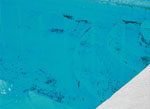 |
|
Black Algae
What is it? Black algae are single-celled organisms that grow in large colonies. They contain chlorophyll like other algae, but they also contain compounds that mask the green color. It forms in cracks and crevices on pool surfaces (especially plaster finishes) and can grow somewhat protected from the surrounding environment due to the formation of a protective layer on the outside of the cell. This makes black algae more difficult to treat and it is somewhat resistant to normal chlorine levels.
To kill black algae:
- Use Banish® as it kills all types of swimming pool algae
- Spot Kill® is specifically formulated to kill black algae on walls
- Spot Kill® WP should only be used on white plaster pools.
IMPORTANT NOTE: Brushing is extremely important when treating black algae because that protective layer has to be broken in order for the sanitizer or algicide to come in contact with the cells.
5 steps to prevent algae growth:
- Maintain a sanitizer residual of 1-3ppm
- Do an initial and weekly application of a preventative algicide (such as Backup 2)
- Shock routinely
- Make sure there is adequate circulation and filtration
- Brushing surfaces is vital

|
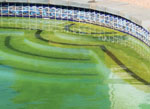 |
|
Green Algae
What is it? Common “green” algae are microscopic, aquatic plant-like organisms and can be free-floating or wall clinging. Algae grows in salt or fresh water and thrives in temperatures above 85°F. In fact, it can “bloom” overnight. Algae spores constantly enter pool by rain, wind, animals, toys or swimsuits and left unchecked, can clog filters and create surface damage.
To kill green algae:
- Use Banish® as it kills all types of swimming pool algae
5 steps to prevent algae growth:
- Maintain a sanitizer residual of 1-3ppm
- Do an initial and weekly application of a preventative algicide (such as Backup 2)
- Shock routinely
- Make sure there is adequate circulation and filtration
- Brushing surfaces is vital

|
\ |
|
Yellow (Mustard) Algae
What is it? Mustard algae is a chlorine-resistant form of green algae that often resembles dirt or sand on bottom or sides of pool. It contains compounds that act as a defense mechanism against the oxidation efforts of sanitizers, helping it survive even in highly chlorinated conditions. This factor can even create a large chlorine demand in certain situations. Mustard algae can be brushed away very easily, but returns quickly.
To kill mustard algae:
- Use Banish® as it kills all types of swimming pool algae
5 steps to prevent algae growth:
- Maintain a sanitizer residual of 1-3ppm
- Do an initial and weekly application of a preventative algicide (such as Back Up® 2)
- Shock routinely
- Make sure there is adequate circulation and filtration
- Brushing surfaces is vital

|
 |
|
Cloudy Water
What is it? Cloudy water is a hazy, murky appearance that is caused by introduction of suspended particles that are invisible to the naked eye. A similar analogy would be the particles in air that cause smoke. These impurities are introduced to the water from a myriad of environmental sources, even bathers and source water. Particles can intensify and cause water to cloud due to improper water balance, low sanitizer levels and/or lack of routine oxidation, poor filtration or inadequate circulation.
To fix chemical causes of cloudy water:
- Test water to determine current chemistry conditions
- Add Lo 'N Slo® if pH is high
- Add BurnOut® 73 or BurnOut® 35 to oxidize contaminants
To fix equipment causes of cloudy water:
- Improper filtration is the largest cause of cloudy water
- Use Strip Kwik ® or Kleen It ® to clean dirty filter media
- Add Pool Tonic™, Natural Clarifier or Polysheen Blue® to enhance filtration
- Check pool returns and make sure they are angled properly
To prevent cloudy water:
- Add Pool Complete™ to your weekly maintenance routine to improve clarity and reduce contaminant levels
- Backwash filter when necessary
- Chemically clean filter every 4-6 weeks
- Replace filter media as directed
- Run pump at least 10-12 hours per day
- Maintain proper water balance
- Oxidize pool weekly to destroy contaminants
- Shock pool weekly to destroy contaminants (such as perspiration, suntan lotions, hair sprays, body oils, urine, pet dander, and cosmetics.)

|
 |
|
Evaporation/Heat Loss
What is it? Local climate and weather conditions have a significant impact on the energy efficiency of a pool. Evaporation is more noticeable in drier areas and climates with clear, cold nights often see reduced water temperatures due to exposed water surfaces. These two effects are interrelated as well since when pool water evaporates, heat is also lost from the pool to the air. Other environmental conditions such as humidity or strong winds can also contribute to the problem. The result is increased costs to constantly refill and reheat your pool.
To prevent evaporation and heat loss:
- The solution is to either physically cover your pool when not in use or to apply products that work to reduce the impact on the water surface.
- Add Smart Shield™ as needed to create a thin, invisible barrier that will reform after activity

|
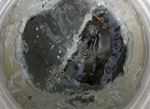 |
|
Excessive Chlorine Loss
What is it? The consistent inability to maintain chlorine levels is also called “chlorine demand” and is most often caused by a high level of inorganic and organic contaminants in the water. Those contaminants force the chlorine to work extremely hard to oxidize them, leaving little chlorine to protect swimmers. Proper chlorine levels cannot be reestablished without first eliminating the contaminants. External factors such as sunlight and heat also contribute to chlorine loss.
To fix excessive chlorine loss:
- Take a water sample to your BioGuard Dealer to determine the extent of the demand
- Add Pool Tonic™ to help remove contaminants
- Add BurnOut® 73, BurnOut® 3 or BurnOut® 35 to correct sanitizer levels
To prevent excessive chlorine loss:
- Add Pool Complete™ to your weekly maintenance routine to reduce contaminant levels
- Maintain an appropriate sanitizer residual of 1-3ppm
- Shock/oxidize routinely or as needed depending on bather load
- Test water frequently and adjust as needed
- Routinely check for circulation and filtration issues

|
 |
|
Foaming
What is it? Foam can be caused by applying a foaming algicide in pools with jetted returns, attached spas or water features. Foaming can also be caused by a foreign contaminant such as soap or oil entering the pool or the build up or organic contaminants in the pool water. Foam should dissipate over time, but the use of anti-foaming agents will help clear the foam much more rapidly.
To eliminate foaming:
- Apply Anti Foam to get rid of foam quickly
- Add Pool Tonic™ to remove contaminants that may be causing the foam
To prevent foaming:
- Switch to non-foaming algicide such as Banish® or Algae All 60®
- Shock/oxidize routinely
- Add Pool Complete™ to your weekly maintenance routine to reduce contaminant levels

|
 |
|
Scale
What is it? Scale formation is created when there is an oversaturation of minerals in the pool water and water conditions do not allow them to remain dissolved or soluble. Those conditions may be high calcium hardness, high temperatures and/or high pH. The minerals drop out of solution and attach to pool walls and equipment and can damage them if the scale is not removed. Salt cell generators are especially susceptible to scale buildup due to the intense water conditions within the cell itself.
To remove scale:
- Add Scale Inhibitor to gradually remove scale from pool surfaces
- Use a brush and Off The Wall® to quickly clean surfaces near the waterline
- Use SaltScapes™ Cell Cleaner to remove scale from salt generator cells
To prevent scale:
- Add Scale Inhibitor for traditional chlorine pools and Mineral Springs® Stain and Scale or SaltScapes™ Scale Defender for salt pools

|
 |
|
Metal Staining
What is it? Pool water, equipment and surfaces can become discolored due to contamination, sunlight and the presence of metals in pool water. Metals are often introduced into the water via source water, equipment (corrosion of heater parts), pool chemicals or other pool devices. Changes in water balance (usually from an increase in pH or application of a shock product) can cause the metals to become insoluble and allow them to drop onto the pool surface, resulting in staining. Iron and copper are the two most common types stains. Some stains may be organic in nature (such as black algae and pink slime) and should be treated with algicides and shock.
To remove metal stains:
- The key to stain removal is identifying the stain, making it soluble again and removing it from the water
- Erase® Stain ID Kit helps identify the specific type of metal stain in your pool
- Use Iron Stain Remover to eliminate recent stains
- Add Pool Magnet® Plus: Ties up metals in pool water
- Sparkle-Up®: Aids physical removal of metals through filter
To prevent metal stains:
- Pool Magnet® Plus: Ties up metals in pool water
- Sparkle-Up®: Aids physical removal of metals through filter

|
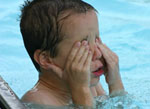 |
|
Eye/Skin Irritation
What is it? Eyes and skin can become irritated after spending time in the pool for various reasons. Out of balance pool parameter, specifically pH, can cause eye and skin irritation in swimmers. A build up of contaminants in pool water can also create chloramines (a chlorine smell) and contribute to eye/skin irritation.
To adjust pH:
- Test water to determine current chemistry conditions
- Test water before adding product to ensure which factors need to be adjusted
- Add Lo 'N Slo® if pH is high, Balance Pak® 200 if the pH is low
To remove contaminants:
- Add BurnOut® 73 or BurnOut® 35 to oxidize contaminants
- Add Pool Tonic™, Natural Clarifier or Polysheen Blue® to enhance filtration
To prevent irritating conditions:
- Keep pool water balanced according to suggested parameters.
- Add Pool Complete™ to your weekly maintenance routine
- Backwash filter when necessary
- Shock pool weekly to destroy contaminants (such as perspiration, suntan lotions, hair sprays, body oils, urine, pet dander, and cosmetics.)

|
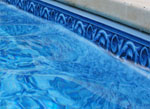 |
|
Waterline Buildup
What is it? A greasy coating on the walls along the waterline of the pool is evidence that there is a saturation of undissolved materials in the water while a ring of rough patches may be a sign of scale. Most of the time, oils,lotions, and other organic contaminants that enter the water via swimmers cause the greasy buildup. Scale conditions are due to hard water problems or failure to correct water balance issues. Please visit the Scale troubleshooting section for more info on that problem.
To remove waterline buildup:
- Add Pool Tonic™ to remove contaminants such as oils, lotions and grease
- Add Scale Inhibitor to gradually remove scale from pool surfaces
- Use a brush and Off The Wall® to quickly clean surfaces near the waterline
To prevent waterline buildup:
- Add Pool Complete™ to your weekly maintenance routine to help keep surfaces cleaner
- Backwash filter when necessary

|











